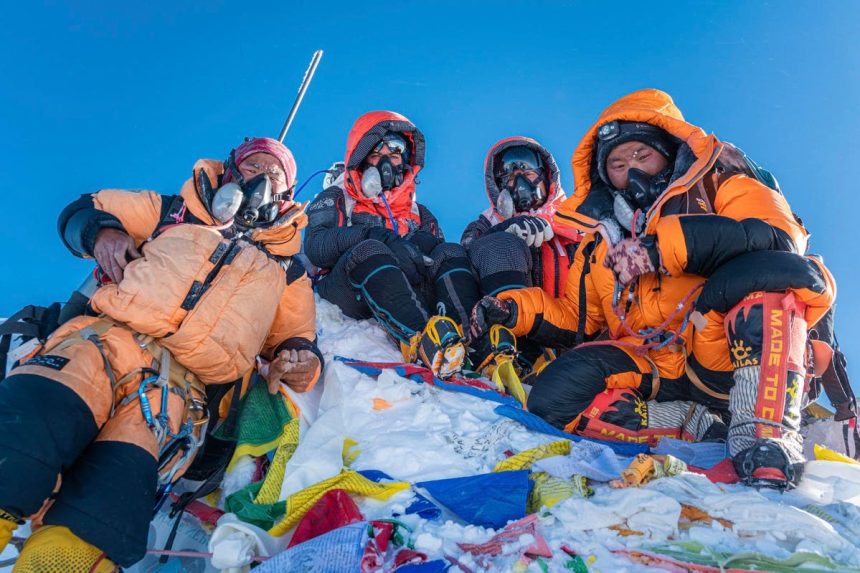As Deaf mountaineers, Scott Lehmann and Shayna Unger are no strangers to challenge. Through their adventures, they seek to shatter misconceptions about what it means to be Deaf, while navigating the rugged terrain of some of the world’s highest peaks. I recently had the opportunity to sit down with them and discuss their experiences, goals, and newest project, “Seeing Beyond”.
Shattering Misconceptions
When asked about the misconceptions they encounter, they shared two main stereotypes. The first is the perception of Deaf climbers as liabilities on mountains due to their inability to hear potential hazards like rock falls or avalanches. The second bias suggests disabled individuals don’t belong in outdoor spaces. The term “accommodation” often intimidates non-disabled people as it implies making unfamiliar changes. This is ironic considering Deaf individuals are already experts at making adjustments due to their lived experiences.
The pair addresses these misconceptions by leveraging their social media platforms to educate others about accommodating Deaf people in mountain environments, all the while continuing to bravely venture into these spaces themselves.
Their Personal Journey
Scott and Shayna’s journey has been profoundly influenced by their upbringing in Deaf communities where they were seen as individuals rather than solely through their disability. They were privileged to have complete access to American Sign Language at home and during their education.
Even in the absence of Deaf outdoor role models, they were inspired by the Deaf adults around them who embraced their identities fearlessly, claiming spaces often barred from Deaf people. This imbued them with a strong sense of confidence that has motivated their mountaineering journey and propelled them to challenge stereotypes.
The Seeing Beyond Project
The Seeing Beyond project is an ambitious undertaking where Scott and Shayna aim to be the first Deaf individuals to climb all seven summits, the highest mountains on each continent. The project is not just about mountain climbing, but transforming global perceptions of Deaf and Hard of Hearing people, improving accessibility to information and education, and increasing representation in the outdoors.
To get involved, people can share their stories, discuss the project with their communities, consider partnerships, or make donations through their website.
Communicating on the Peaks
Being Deaf does not impede Scott and Shayna’s communication. They make use of basic gestures when American Sign Language is difficult to use, and establish rules such as rope-tugging to gain attention. They also teach their climbing partners these basic sign language gestures to ensure smooth communication during their expeditions.
Interestingly, their conversations with other climbers revealed that even hearing climbers sometimes resort to gestures when the weather is too windy for audible communication. This revelation suggests that their experiences on the mountains are not as divergent as one might think.
In situations where traditional sign language becomes challenging due to distance, such as when scaling mountains, Scott and Shayna have adopted a unique approach. “Even though we both primarily use American Sign Language to communicate with each other on a daily basis, on the mountains, we sometimes have to make adjustments. Identifying the small hand movements of ASL becomes difficult when we are far apart,” they explained.
The intrepid duo have created a set of basic gestures to convey critical information. “Here are a few examples of the gestures we use on the mountain: to indicate ‘stop,’ we make a big ‘X’ with our arms; to tell the other person to slow down, we wave our arms above our heads and then down to our waists; we give a thumbs up to indicate that we are okay and thumbs down to signify something is wrong,” they elaborated.
To get each other’s attention, they’ve established specific rules in advance, like tugging a rope three times. If they’re not roped up, the person in front looks back every one or two minutes to ensure the other’s safety and check for any messages.
When interacting with climbers who don’t use American Sign Language, Scott and Shayna teach them these basic gestures. This ensures they can effectively communicate in the challenging mountain environment.
Their approach to communication proves essential, especially in risky situations. During their recent Everest expedition, at 27,000 feet where it was super cold, dark, and windy, Scott found he couldn’t breathe properly with his oxygen mask. “To get the attention of our Sherpa, he tapped him on the shoulder. Scott then made a hand gesture in the shape of a mask over his face and gestured with his hand in front of his neck, using the universal sign for ‘choking’ to indicate that the mask wasn’t working. The Sherpa understood him clearly and immediately assisted him with the mask.”
Risk Management and Safety
Being Deaf requires Scott and Shayna to be more prepared and self-reliant. They meticulously study each route and ensure reliable communication systems are in place. They also rely on a Garmin InReach device for independent communication and weather updates, and establish clear communication protocols with their climbing partners.
Memorable Moments
Their recent Everest expedition left a lasting impression, particularly the final steps to the summit. Standing at the highest point on Earth, surrounded by the beauty of the Himalayas and their team members, was a surreal experience. It represented not just a personal achievement, but a leap forward for the Deaf and Hard of Hearing community.
Advice for Deaf Mountaineers
For Deaf or Hard of Hearing people interested in mountaineering, Scott and Shayna advocate starting with smaller peaks and gradually progressing to more challenging ones. It’s also crucial for Deaf climbers to advocate for their needs, including requesting sign language interpreters.
Overcoming Obstacles
The pair admits that one of the unique challenges they face is working with guides. Many guides back out or suggest easier mountains upon discovering their Deafness. Scott and Shayna have learned to withhold this information until meeting guides in person, then work twice as hard to prove their capability.
Their experiences serve as a stark reminder of the misconceptions and stereotypes that still pervade society. By sharing their stories, Scott and Shayna hope to raise awareness, promote understanding, and pave the way for more inclusive climbing experiences for all.
Read the full article here










